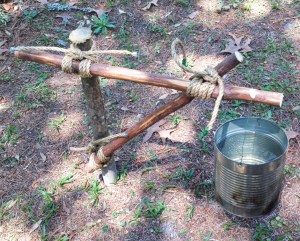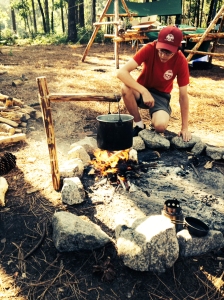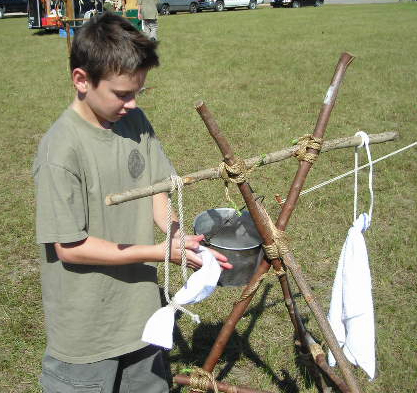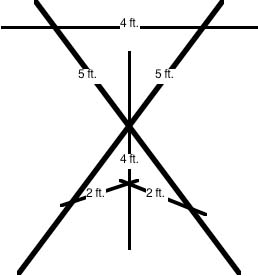Here’s a simple way of setting up a dining fly in an open field

A dining fly is one of the first structures you should put up at camp. But what if you’re in an area away from trees, how do you secure one?
For the next couple of weeks, we’ll be sharing some camp hacks that the BSA’s national camping subcommittee has shared with us. This week’s tip involves how to set up a dining fly. Special thanks to Larry Green for the tips and text below.
In the Camping merit badge pamphlet, under the “Managing Your Campsite” section, it reads, “Set up a dining fly first. That will provide shelter for food and you in case of rain, and will give a sense of where you will center most of your camp activities.”
It’s a regular practice that the dining fly is the first thing to go up and the last thing to come down. Here’s one simple way for a patrol to set up their fly when there are no trees for the ridge line.

- Layout the tarp and attach a guyline to each corner with two half-hitches or a bowline.
- Pound in stakes five feet away and at a 45-degree angle from each corner of the tarp.
- Apply a taut-line hitch between the stakes and the tarp’s corner grommets.
- On each side, join two Scout staves together with two round lashings for the upright poles.
- Secure a ridge line to the upright poles with a series of half hitches.
- With the ends of the ridge line attached to their stakes, the tarp is raised and tension on the guylines is adjusted.

Watch these videos for techniques and tips below.
Share this:
Scout Stave Floating Flagpole
A crew of Scouts went about erecting a FLOATING FLAGPOLE made entirely of Scout staves. They lashed together five staves for the pole and two staves each for the three supporting uprights. The idea was to rely upon the strain of the guylines to keep the uprights straight, without sinking them into the ground. The problem was the two staves making up each upright were just too rickety to effectively withstand the stress created during the hoisting process.
All in all, it worked, but attention should be directed to the lashings joining the stoves for the uprights. —> Use longer lashing ropes or apply three round lashings, and, make sure they’re really tight!
An Alternative Approach to Erecting a Better Clothes Drying Rack
Use the support ropes as guylines! Pound in the stakes about 4 feet out from the center pole. BACK TO: A BETTER CLOTHES DRYING RACK

Camp Gadgets made from Scout Staves & Broomsticks

These camp gadgets were featured in the Pioneering Village at the 2017 National Jamboree. All were fashioned out of Scout staves and precut lengths from broomsticks.
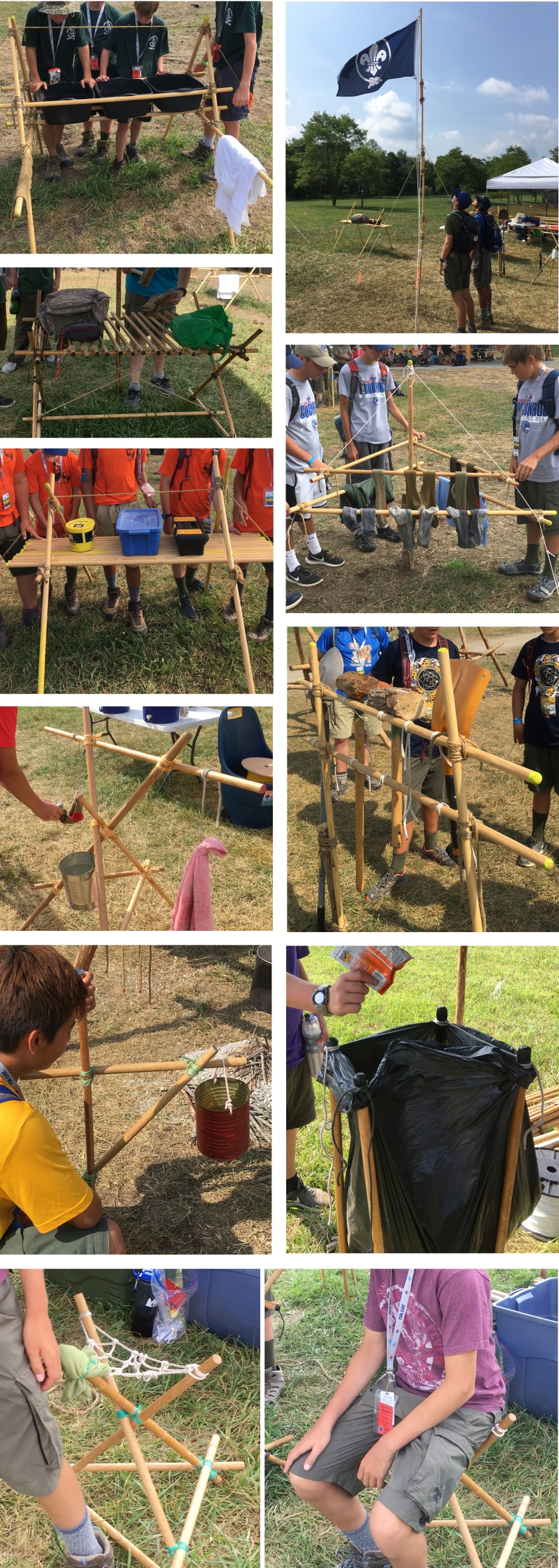
Simple Camp Table
This small camp table can be comprised almost completely of Scout staves. It is 100% functional and provides a convenient raised surface for personal, patrol, or general use. It’s simple design makes it quick and easy to set up, and it is remarkably stable.
Make the table legs. Start by lashing together four Scout staves into two sets of shear legs with 6-foot manila lashing ropes. If you prefer, square lashings can be used instead of shear lashings. (In lieu of Scout staves, straight poles an inch or so in diameter are just fine.)
Lash on the table top supports. Next, with two square lashings, lash a 2-1/2-foot stick to connect each set of shear legs about 30 inches off the ground. (A Scout stave cut in two is ideal.) This will form two A-frames, one for each side of the table. Make sure each of these support sticks are lashed on straight and at the same distance from the bottom end of both sets of legs.

Securely hold up the A-frames. This is surely the best part. Find the midpoint of a 20-foot line. At about two feet away, tie a clove hitch at the top of one of the Scout staves of one of the A-frames. Repeat this process on the other side attaching the line with a clove hitch to one of the Scout staves of the other A-frame.
Secure each end of the 20-foot line to stakes driven into the ground on either side, about 5 feet away, so the line extends out evenly from each end of this table framework. You can use round turns with two half hitches, taut-line hitches, or rope tackles. Here’s the beauty of this configuration: you can manipulate the distance between the A-frames by adjusting the clove hitches, and provide optimum stability to the table by placing a good, reasonable strain on the line at each stake. It will stand up in an impressively rigid fashion.
Lash on the table top. Finally, lay 12 Scout staves, (or similar poles) side by side, on top of the 2-1/2-foot support sticks, and using binder twine, lash them on with floor lashings.
SaveSave
SaveSave
SaveSave
Tripod Straddle Seat
Often times at a campsite, there are no picnic tables with benches, or array of thick, wooden discs from downed trees positioned around a fire site, or fallen tree trunks, or a large outcrop of smooth boulders. So, through the years, the answer to the query, “what will I sit on during a camping trip?” has given rise to many solutions. Some of these are: a square sheet of plastic, a 5 gallon bucket, an ice chest, a carry case, an upside down recycle bin, and of course a wide variety of folding and collapsible camp chairs and stools.
When it comes to actually fashioning a camp seat by making one from what you have on hand, there have been some creative ideas. One featured in Boys’ Life consists of a tarp attached in three places to the legs of a large tripod. But, actually building a real-working chair, by lashing together various-sized poles, can be tedious and time consuming. Also, the finished construction is frequently rickety and uncomfortable.
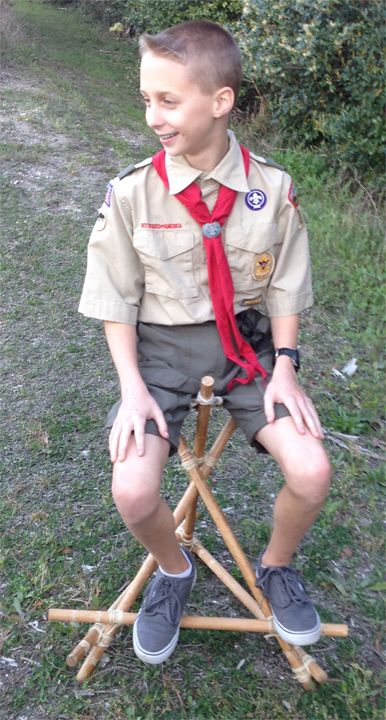 We know, B-P loved camp gadgets, and recently, I was asked to provide a design for a camp chair made with just ropes and poles—something that can be built in a relatively short period of time by one Scout. In the past, I’ve given thought to this kind of campsite improvement, but could never think of anything that would really work…until now. What I’ve come up with is surely not original, but for me, it’s new, and most of all, it works. As I type this, I’m sitting in it! It’s really a simple design. In actuality, it’s very similar to the self-standing garbage bag holder, but requires a more concerted approach. After all, it’s not for trash; its for supporting one’s body.
We know, B-P loved camp gadgets, and recently, I was asked to provide a design for a camp chair made with just ropes and poles—something that can be built in a relatively short period of time by one Scout. In the past, I’ve given thought to this kind of campsite improvement, but could never think of anything that would really work…until now. What I’ve come up with is surely not original, but for me, it’s new, and most of all, it works. As I type this, I’m sitting in it! It’s really a simple design. In actuality, it’s very similar to the self-standing garbage bag holder, but requires a more concerted approach. After all, it’s not for trash; its for supporting one’s body.
MATERIALS
- three 32-inch sticks for the legs
- three 24-inch sticks for the bottom braces
- one 10-foot length of binder twine for the tripod lashing -or- one 10-foot lashing rope
- six 6-foot lengths of binder twine for the square lashings -or- six 6-foot lashing ropes
- one 15-foot length of 1/8 to 1/4-inch braided nylon cord for the seat

The sticks you use for this seat are vital to its stability. They have to be strong. It’s going to be rare to get natural wood on the camping trip that’s straight enough and strong enough to furnish these materials. This would be ideal, BUT, Leave No Trace and Outdoor Ethics dictate we don’t cut these sticks from living trees. If they can be harvested from downed trees, great! If Scout staves were, for some reason, to be cut in these lengths, I’d say use them. They’d be perfect. (Don’t go cutting up Scout staves!) Good broom sticks are 1-inch in diameter and they’re available by the box full. Cut those up. They can be used again and again for a variety of Scout Pioneering gadgets.
PROCEDURE
 There are two main objectives when building this camp seat. One: the tripod legs must be spaced evenly from one another so the structure is well-balanced. Two: the lashings and how the webbing is attached to the legs must be tight enough to keep from slipping.
There are two main objectives when building this camp seat. One: the tripod legs must be spaced evenly from one another so the structure is well-balanced. Two: the lashings and how the webbing is attached to the legs must be tight enough to keep from slipping.
Prepare the sticks: Since it’s so important to have everything even, before lashing can begin, points where the sticks will meet should be marked out. If the materials will be used repeatedly, it will be practical to mark out a complete series of points on every stick so that each can be used interchangeably.
On the 24-inch sticks, mark out 2 inches, 4 inches, and 6 inches from each end.
On the 32-inch sticks, mark out 2 inches, 4 inches, and 6 inches on the bottoms for the braces, 20 inches up from the bottom for the tripod lashing, and 30 inches up from the bottom for the webbed seat.
Note: When using smooth poles, in order to keep everything from sliding, use a bastard cut wood rasp file to cut a slight roughed out indentation around the diameter of the sticks at the above points. This should be done before a Scout assembles his seat.
Lash together the tripod: With the 32-inch sticks parallel to one another, lash them together at the 20-inch mark with a tight tripod lashing. Racking turns are preferred, weaving the wraps in and out between the poles. See that the line bites into the sticks as much as possible where they have been roughed out. Spread the legs out making sure the middle leg, which will eventually be the front leg, is on top of the two outside legs.
Lash on the bottom braces: Turn the tripod upside down. With tight square lashings, lash the 24-inch braces to the legs, marrying them to legs at the corresponding markings: 2-inch to 2-inch, 4-inch to 4-inch, 6-inch to 6-inch. Doing so will assure the legs are spread equally apart into an equilateral triangle. Again, make sure the line bites into the sticks as much as possible where they have been roughed out.
Attach the framework for the mesh seat: Turn the tripod right side up. Attach one end of the 15-foot nylon cord to one leg at the 30-inch mark with a tight clove hitch. Leave enough tail in the short end and in it tie a small loop with a bowline. With another tight clove hitch, join the long end of the cord to the next leg at the 30-inch mark, pulling the cord taut between the legs. Form the half hitches of these clove hitches on the outside of the legs, and make sure the line is biting into the roughed out part of the sticks. Do the same with the third leg.
After a clove hitch has been applied to each leg, carry the end of the cord through the loop of the bowline. Pulling it taut, secure it to the loop with two half hitches like you would with a rope tackle. The cord now forms a triangle which will serve as the frame for weaving a seat.
Weave the seat: Pulling the cord taut as you go, attach it to the nearest part of the triangular frame with a clove hitch and then stretch it diagonally to the opposite leg of the triangle. Tie a clove hitch there and proceed to the next leg of the triangle, tie a clove hitch, and so on. When you have zig-zagged throughout the entire triangle, you will have enough line to tie additional clove hitches down the middle of the triangle where the line intersects with previous portions. Finish by tying a clove hitch to the middle of the first leg. Any excess line can be attached with additional half hitches to the nearest 32-inch stick.
Sit on your camp seat: The front of the seat is the leg of the tripod that is on top of the two others. Straddle this leg and sit down. If your chair has been formed symmetrically and lashed together tightly, and if the webbing was tied on tightly in the right places, you will now be perched very comfortably!
Single Fire Bucket Holder
One of the essential mandates in the BSA’s Outdoor Code is: BE CAREFUL WITH FIRE.
- I will prevent wildfire.
- I will build my fires only where they are appropriate.
- When I have finished using a fire, I will make sure it is cold out.
- I will leave a clean fire ring, or remove all evidence of my fire.
In addition to being the height of simplicity, this Single Fire Bucket Holder makes an invaluable contribution towards safety around the fire circle. Since it’s always a safe bet to have a supply of water right near our cooking and campfires, why not add some convenience and accessibility in our campsites, especially because when fire buckets are on the ground, they’re frequently knocked over, inadvertently kicked, and even stepped in!
The design for this easy camp gadget is very straightforward. The diagonal support brace forming a triangle is what makes it work, and without it, the notched stick could never securely support the bucket.
Here are the suggested materials:
- one 3-foot x 2-inches pioneering stake
- two 2-foot x 1-inches straight sticks (one with a notch at one end)
- two 10-foot x 1/4-inches lashing ropes
- one 6-foot x 1/4-inches lashing rope
The procedure is simple.
- Where you want the fire bucket, pound in the stake deep enough so it doesn’t shake.
- Lash on the notched stick with a tight square lashing extending out from the stake at a right angle.
- Near the notch, lash on the support brace at a 90º angle (not too tightly) and then position the stick so it intersects with the pounded in stake in such a way that the notched stick remains extending straight out.
- Secure this position with a tight Square Lashing.
Scout Stave Dish Washing Rack
Background and History. Washing mealtime utensils on a camping trip can range from using paper plates (no washing) to “Philmont-style” (lick ’em clean and sanitize in boiling water). Through the years, Scouting has come up with a variety of “dish washing assembly line” configurations. For a wide range of field applications, the three container approach has proven itself tried and true.
Here’s the method featured in the current edition of the Scouts BSA Handbook:
- 1st container: Wash Pot (hot water with a few drops of biodegradable soap)
- 2nd container: Cold-Rinse Pot (cold water with a sanitizing tablet or a few drops of bleach to kill bacteria)
- 3rd container: Hot-Rinse Pot (clean, hot water)
On many overnight camping and backpacking trips, this approach has been adapted, sometimes combining the second and third containers into one 8 quart pot. In all cases, the initial step is to clean or scrape off as much excess food as possible into a designated receptacle, before placing anything into the 1st container. Most often the final step, is to let all washed items air dry on a plastic sheet. Even when wash basins are used on front-country, “car-camping” trips, the whole production frequently takes place right on the ground. This is always the case when there are no picnic tables, limited table space, or when tables are being used for other things. Improving the campsite, making it more comfortable, making kitchen tasks more convenient, being resourceful and using one’s ingenuity is what creating camp gadgets are all about. That’s why the Scout Stave Dish Washing Rack was devised.
Two challenges. 1) Drawings for dish washing rack designs are common. But, until you make one and try it with full containers of water, it’s difficult to realize what the main challenge really is—to keep the containers from crashing down because they’re too heavy! Depending on the containers used, an average wash basin won’t have enough of a lip to hold it in place or is just too flimsy to keep it’s shape when filled with water. That’s why lashing together a framework alone usually won’t suffice. Therefore, in addition to the framework, this design includes a bottom platform made up of two Scout Staves for the basins to rest upon, which solves the weight issue. 2) The next challenge is one that’s common to many a pioneering structure, be it large or small. How do we keep the rack itself from falling over? We overcome this basic concern by bringing into play the same stability solution used in making a simple camp table. It’s exactly the same concept that keeps a Double A-Frame Monkey Bridge erect. Like the table, we connect two upright A-frames with a rope, and using the same rope, we anchor them securely in place on either side. Here’s what you’ll need:
- ten 5-foot Scout Staves
- fourteen 6-foot x 1/4-inch lashing ropes
- one 20-foot x 1/4-inch lashing rope
- two narrow pioneering stakes
- three wash basins (For convenience, the wash basins we used were very inexpensive and easy to find. Purchased were three 18-quart Sterilite basins from Walmart.)
Make the A-frames. Because the rack will be holding around nine gallons of water, approximately 72 pounds, the lashings for this project need to be especially tight. An easy way to assure you’ll have well-lashed A-frames is to first square lash the tops at 90º and then the ledger to one leg, also at 90º. This will create some strain on the lashings when the other leg and the other end of the ledger are lashed together, yielding a nice tight A-frame. (Careful it’s not too tight, and of course you can always start with a shear lashing at the top.) With these Sterilite wash basins, lash the ledger in place about 28 inches from the top of the legs. Since all we’re using are Scout Staves, in this design one side of the ledger will purposely extend out much farther than the other on each A-frame—a place to hang some towels (or whatever).
Connect and stand up the A-frames. Tightly lash two staves to the outside of the legs of each A-frame, about 20 inches from the top. The front and back edges of the wash basins will rest on these staves. Hammer in two stakes about 12 feet apart where you want the rack to be located, and position the connected A-frames between. Halve the 20-foot lashing rope and approximating the midpoint between the A-frames, secure the rope to the top of one leg with a clove hitch, and pulling the rope to the other A-frame, repeat the process on the top of a leg on the other side. Tie the ends of the rope to the stakes on either side, securing the ends tightly with tautl-line hitches. (If preferred use roundturns with two half hitches.)
Add the two-stave basin supports. The A-frame ledgers will now serve to do something more than keep the A-frames’ legs from shifting. They’ll now also support the two remaining staves that assure the basins stay put! Lash these two staves parallel to one another on top of the ledgers, on either side of the rack.
Place the basins on the rack. Once you check to see all the lashings are tight, and the central rope is secure and stabilizing the structure, then you’re ready to bring on the basins. Position them side by side and fill them about 3/4 of the way up.
The BSA Supply Division’s Scout Hiking Staff is still the best deal on the market for Scout Staves. Order them through your council service center.
Ideal Camp According to Baden-Powell
“My ideal camp is where everyone is cheery and busy, where the patrols are kept intact under all circumstances, and where every patrol leader and Scout takes a genuine pride in his camp and his gadgets.” — Lord Baden-Powell
It should be the same today! It really should! Today’s Scouts cheerfully pulling together towards the common goal to make and keep their camp comfortable and organized, everyone doing their part and helping one another—that’s sheer poetry! The fun the Scouts have is inherent in putting into action the timeless Scout skills they’ve acquired to create a site that is amazing. Their camp is their very own, personalized outdoor home away from home. They are remarkably proud of what they’ve accomplished as reflected by their useful and ingenious camp GADGETS, and exemplified by their shining ability to function as a well-run Scout patrol.
Scouting’s Traditional Outdoor Skills
Dovetail Notch for Camp Gadgets: Pioneering Without Rope
Back in the spring of 1976, while walking through the Mortimer L. Schiff Scout Reservation, then the BSA National Training Center, there was a memorable encounter with a tall man. Seeing the young Scouter, the tall man figuratively embraced him with a smile, warmly acknowledging the younger man like they were lifelong brothers in a worldwide family. A light-hearted conversation ensued. The tall man was Ken Cole, Jr., editor of the 1967 edition of the Boy Scouts of America Fieldbook which had just recently been reprinted.
Here’s an amusing side note: With a twinkle in his eye, he related a little “story” about how on his flight over to Schiff, a passenger sitting next to him in the smoking section asked him for a light. He described how he casually retrieved some belly button lint from a plastic bag, and nonchalantly lit the man’s cigarette with flint and steel. Boy, was that guy ever surprised. The account was related with such sincerity, the thought whether or not this actually happened never occurred to the young man. Ken was so engaging and easy to be around, it really didn’t matter.
Ken happened to be carrying a bow saw, and extolled its virtues as a most useful woods tool. He then bragged about how wonderful was the dovetail notch, and proceeded to effortlessly create one in a stick he picked up from the side of the path. It was a happy demonstration. Ken was a very happy guy.

There’s a whole section on “dovetailing” in the 1981 printing of the BSA Pioneering Merit Badge Pamphlet: “With the handy bow saw and a pocket knife, you can make excellent joints for log structures without lashings. This is done by making a triangular notch in the “receiving” log and a tapered end in the other log or pole. This is called “dovetailing” and if done correctly, it provides a tight, rigid joint that is neat and strong.”
The following is extracted from the 1976 Boy Scout Fieldbook:
When you must hold two pieces of wood together, and you don’t have rope for lashing and there are no nails or wire, you can do it with a dovetail notch. The dovetail joint, as you know, is a familiar cabinet makers trick. However, you don’t have to be a skilled carpenter to make this dovetail notch. Four cuts by a saw and a few strokes with your knife to pry out the wood in the notch is all there is to it. The notch will hold slender unshaped round sticks for quick work and thicker tight-fitting dovetails for heavy loads.
0.000000
A Better Clothes Drying Rack
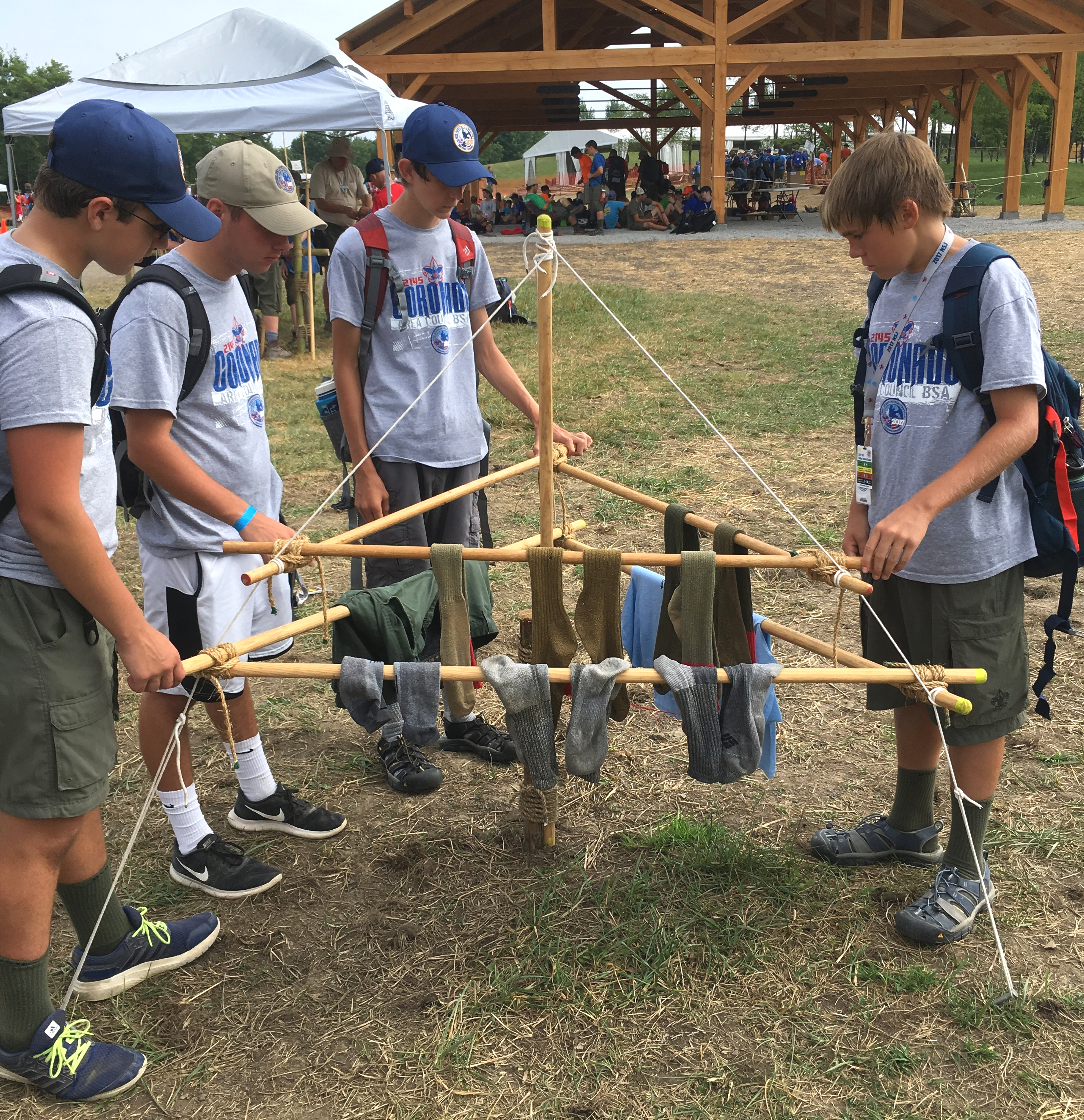 You’ve got to love this design. It’s compact, it’s sturdy, and it’s ingenious!
You’ve got to love this design. It’s compact, it’s sturdy, and it’s ingenious!
This drying rack is based on suspending two concentric, equilateral triangles to make six cross sections for hanging wet clothing or towels during a long term encampment, and there’s no reason you can’t put it up on an overnighter if there’s a practical need. All that’s been said before regarding the advantages of this kind of campsite improvement apply to this simple camp gadget:
- It takes up less space while drying more wet things.
- It eliminates the clutter of clothing and towels haphazardly strewn around on tables, tree branches, tent platforms, or overcrowded on a disorganized array of drooping clothes lines.
- It can be set up in a location where there is the most sunshine.
- It’s especially useful when camping in an open area with few trees.
Materials (adapt these as you like)
- three 4-foot x 1-inch sticks
- three 5-foot x 1-inch sticks (Scout staves are ideal)
- one 6-foot x 1-1/2 to 2-1/2-inch straight pole for the upright (or an additional 5-foot Scout stave)
- one 30-inch pioneering stake
- eight camp gadget lashing ropes (6 to 10-foot)
- three 15-foot lashing ropes
- three small stakes
Procedure
Lash the triangles. Start by lashing together two equilateral triangles, one smaller for the top (three 4-foot sticks), and the larger one for the bottom (three 5-foot staves). Use square lashings. One easy way is to lash two at 90° and then bend them in and tie the third square lashing to make the triangle. This yields a nice, tightly-lashed triangle, (but be careful you’re not putting too much stress on the ropes and poles when preparing to apply the third lashing).
Erect the upright. Pound in a pioneering stake and lash the 6-foot pole to it securely with two tight strop lashings or round lashings. Making this upright stand up vertically without moving or wobbling at all is a key to a good and sturdy clothing dryer. So, solidly pound in the stake and make sure it’s as straight as possible. Also, make sure the lashings are well-tied and tight.
—> ALTERNATIVE APPROACH: A clothes drying rack can be erected without having to either pound in a stake or sink the center pole, by using the same principle as when erecting a flagpole. The key is using the support ropes as guylines. SEE PHOTO.
Attach the triangles. Lay the triangles on the ground over the upright, first the larger triangle, and then the smaller one on top.
Using rolling hitches, tie the three 15-foot support ropes to the top of the upright. (Roundturns with two half hitches also work just fine.)
Tie each corner of the smaller triangle to a support rope so it will be suspended about 5 feet above the ground. Use clove hitches which can be adjusted as necessary to assure the triangle hangs evenly and the 4-foot sticks are horizontal. Continuing with each of the three support ropes, repeat this process for the larger triangle so that it will hang about 4 feet above the ground.
Anchor the support ropes. Hammer in a small stake a foot or so out, in line with each corner of the bottom triangle. Using the remaining length of the support ropes, attach them to the stakes with a simple taut-line hitch. This will further stabilize the clothing dryer and enable you to make fine-tune adjustments to the way the triangles lay. (You can also just make them fast to the stakes with a roundturn with two half hitches, or another clove hitch.)

Self-Standing Garbage Bag Holder
Getting that garbage bag off the ground has all kinds of advantages, but sometimes, you can’t hammer sticks into the ground to make the easy three stake holder. There might be any number of reasons. The ground’s got too many rocks. The ground is rock. You’re in a parking lot or on the sidewalk during a fundraiser. You’re indoors.
In these cases, to hold up a trash bag (when there is no trash can), you can simply lash three Scout Staves or similar poles into a tripod and lash on some short cross pieces to keep it stable. All that’s required is seven lashing ropes, one for a tripod lashing and six for square lashings. For the poles you need three 4 to 5-foot sticks for the tripod legs, and three short sticks for the tripod leg supports.
Note: The tripod lashing is tied below the middle of the longer sticks. The length that the sticks extend on top of the lashing will be determined by the size of the bag your holding. Also, to secure the bag on the holder, and too shorten or lengthen the amount the bag hangs, you can fold the top of the bag as much or as little as you like over the three upper leg extensions.
Tool Rack 2
Please refer to the “sales pitch” provided in the Tool Rack post spelling out all the advantages inherent in building one of these simple camp gadgets. It is a good-looking campsite improvement project, but mainly, it’s got major functionality.
The main difference between this version and the other is with the first tool rack, all the tools are hung, suspended by a cord from the upper cross piece and are supported by resting against the lower cross piece. In this tool rack, the tools’ handles are slipped in between two parallel cross pieces. This way, they’re held very nicely in place, and any shifting or wobbling around, often experienced in the first rack, is eliminated.
The two racks are also constructed in like manner, again refer back to the Tool Rack post. No need repeating it here. However, in this version, the diameter of the two 6-foot uprights need to be a little larger than the diameter of the thickest handle of any tool you’ll be hanging.
When you’re ready to lash on the cross pieces, lash on the first higher than the longest tool. It needs to be at a height easy enough to comfortably place the tools on and take the tools off the rack, without needing to reach up too high or bend over. Secure the first cross piece in front of the uprights with a couple of tight square lashings, and then secure the second cross piece to the uprights in exactly the same position, but on the other side of the uprights. You’ll be tying a tight square lashing here too, and there’s plenty of room to wrap and frap. That’s all there is to it.
By the way, if you’d like to erect a cover over the tool rack, lash another cross piece to the very top, and rig up a tarp, using this third cross piece as a ridge pole.

SaveSave
Hand Wash Station
This wash station is the ideal First Class Camp Gadget! It’s sturdy, portable, and very useful when camping away from washroom facilities. Inherent in its design is a sound approach to a variety of pioneering concepts and skills. When this project’s built with all the lashings tight and all the legs, cross bar, and support pieces properly positioned, it’s a fine example of a well-engineered, highly functional camp gadget. Each of the three legs making up the tripod gets a lashed on support piece, and the wash station’s stability stems from the fact the design contains three triangles.

To start, you’ll need six good, straight sticks as follows:
- two 2-foot x 3/4 to 1-inch for the leg braces
- two 4-foot x 3/4 to 1-inch for the back leg and crossbar
- two 5-foot x 3/4 to 1-inch for the front legs
For the lashings, you’ll need:
- one 10-foot x 1/4-inch manila rope for the tripod lashing
- six 6-foot x 1/4-inch manila ropes for the square lashings
NOTE: This and several types of camp gadgets can be happily lashed together simply using binder twine!
You’ll also need
- bar of soap in a sock with a 3-foot cord
- small to medium-sized towel with a 3-foot cord
- No. 10 can with a bail or 4-quart cooking pot with a bail.
Here’s the assembly procedure:
Make the tripod. Using the 10-foot rope, lash the two 5-foot sticks and one 4-foot stick together with a tight tripod lashing. The 4-foot stick should be in the middle. Make sure the “butt” ends of all three these sticks are even. Separate the legs and set the tripod up. The success of this project relies on a well-tied, tight tripod lashing.
Lash on the braces. Using four tight square lashings, with the 6-foot ropes lash one end of the 2-foot sticks to the 5-foot legs and the other end of the 2-foot sticks to the four-foot leg.
Lash on the crossbar. Using two more square lashings, tightly lash the other 4-foot stick to the top extended sections of the two 5-foot sticks to make a cross bar for the towel and soap-in-a-sock.
Add the soap, water, and towel. Tie the end of one 3-foot cord to the soap-in-a-sock and the end of the other 3-foot cord to the towel, and hang them on either side of the 4-foot crossbar.

Hang the can filled with water to the end of the 4-foot stick extending from the front of the tripod.
During the camping trip, change the water as necessary. See that the soap-in-a-sock is not left in the can after use as it will melt.
One of the beauties of using metal containers is that in cold weather, the can of water can be heated in the fire.
Camp Clothing Drying Rack
Designed very closely along the lines of the Simple Camp Table, this is an easy solution to how to dry wet clothing and towels at a long-term camp.
- It takes up less space while drying more wet things.
- It eliminates the clutter of clothing and towels haphazardly strewn around on tables, tree branches, tent platforms, or overcrowded on a disorganized array of drooping clothes lines.
- It can be set up in a location where there is the most sunshine.
- It’s especially useful when camping in an open area with few trees.
A large camp clothing drying rack can be built using four 6-foot x 2-inch spars, or a smaller one with four 5-foot Scout staves.

Build the framework. For each side of the rack, lash two poles with a tight shear lashing. Make sure the distance where they intersect at the top is the same for each pole.
If you’re making a larger rack, strengthen the sides by connecting the poles with a 4 or 5-foot cross brace, lashed on with tight square lashings. This will form an A-frame for each side. (For a smaller rack, all you’ll need are the Shear Lashed staves forming two inverted ‘Vs’.)
Set up the supporting line. What holds up the sides of the rack and serves as the highest drying line is a long rope. A 50-foot x 1/4-inch manila rope works great, but most any long cord will be fine. Drive in two narrow pioneering stakes, one for each side, extending about ten feet beyond the length of the drying rack. The larger the rack, the longer this length can be.
Attach the long rope to each rack side with a an Open-Ended Clove Hitch around the top of one pole, right where they intersect. The distance between each side is the length of the drying rack where wet clothes and towels will be hung.
Raise the rack. After the clove hitches are in place, lift up one rack side and secure the end of the long rope to the corresponding stake with a taut-line hitch or rope tackle. Repeat this process with the other rack side. Tightening the ropes at the stakes is what keeps the drying rack firmly in place.
Add some lines. Adding more lines increases the capacity of the rack to dry more and more wet clothing and towels. Tie additional ropes or cords to the rack sides at lower heights, attaching one end around the pole with a clove hitch or two half hitches, and the other at the other pole with a taut-line hitch. To increase the rack’s stability, you can heel in the butt ends of the rack sides an inch or two into the ground. This will keep them from shifting when the additional lines are made taut.
NOTE: For a very sturdy drying rack, replace the single stake at each end with a 1-1 anchor, and then, instead of using shorter lines secured only between the rack sides, use long ropes or cords, attaching them with a clove hitch at the poles, and then around each 1-1 anchor with a tight taut-line hitch or rope tackle. If you’re using manila (which has a low stretch factor) as your long rope, and you’re getting a decent strain on the line, there’s no reason you can’t just secure the rack to the stakes using roundturns with two half hitches.










